_We may earn revenue from the products available on this page and participate in affiliate programs. Learn more ›
_
Most Versatile
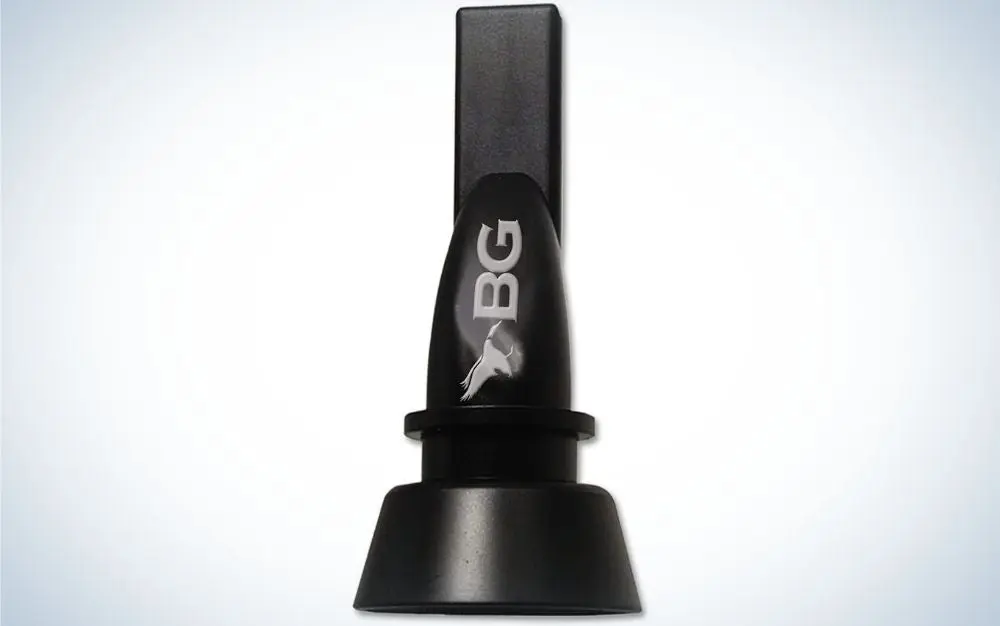
Buck Gardner 6-in-1 whistle
LEARN MORE
Summary
Every duck hunter needs Buck’s elemental 6-in-1 whistle on his/her lanyard. Without a doubt, the best $7 you’ll ever spend on ’fowling gear.
Best Double Reed
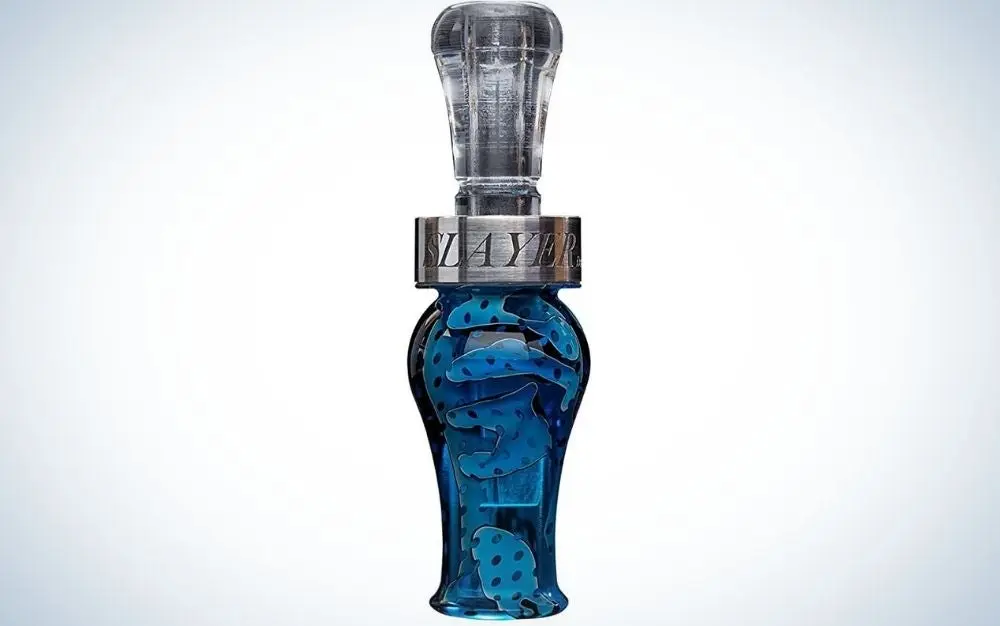
Slayer Calls Drake Slayer
LEARN MORE
Summary
This call is rugged and has an eye-catching acrylic construction. It has good volume control and is made in the USA.
Most User-Friendly
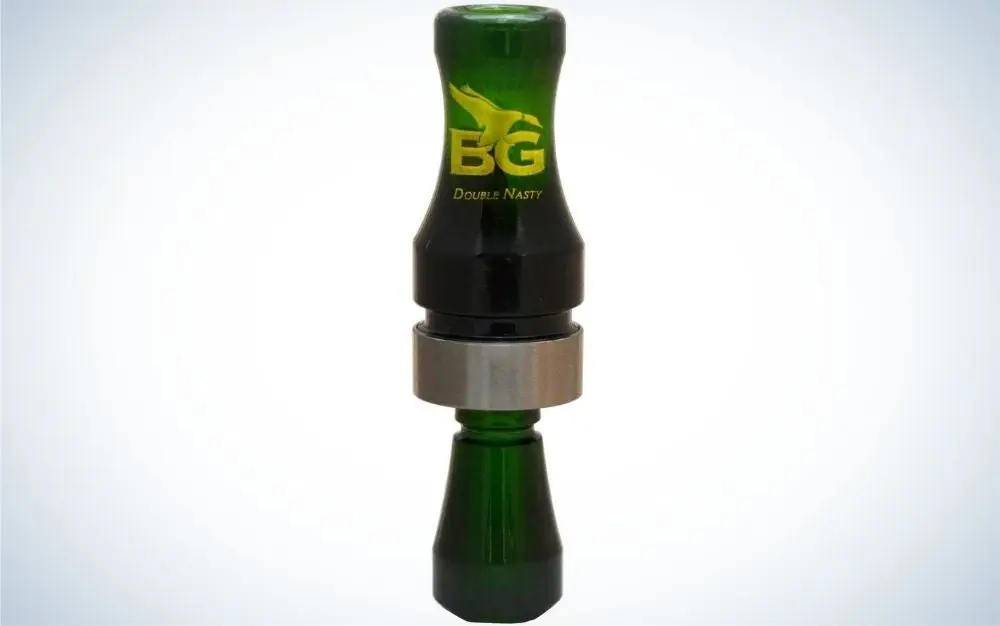
Buck Gardner Double Nasty
LEARN MORE
Summary
This full range double reed design has good highs and lows. It is hand tuned with acrylic, polycarbonate, and hybrid construction.
In regards to ducks, duck callers, and duck calling, Nash Buckingham is quoted saying, “A duck call in the hands of the unskilled is conservation’s greatest asset.”
Mr. Buckingham may be spot on when it comes to poor duck calling being responsible for saving the lives of countless mallards over the last 100 years or so. But not-so-good duck calling can’t be blamed on the calls themselves. No, sir. Today, duck hunters
are blessed with an almost infinite variety of call options—single reeds, double reeds, triple reeds, mylar, metal, Old School true cork wedges, wood, acrylic, polycarbonate, hybrids. You name it, and it’s out there.
So how does the new duck caller start down the road to selecting their first call? Or what might the veteran take a look at when he or she decides it’s time for another (which, by the way, it always is)? Here is an in-depth look at the best duck calls available.
Best Overall: Bill Saunders EZ7
Most Versatile: Buck Gardner 6-in-1 whistle
Best Single Reed: Field Proven Single Shot
Best Double Reed: Slayer Calls Drake Slayer
Best Wood Duck Call: Primos Classic Wood Duck
Best on a Budget: Big Lake Calls Duck Popper Hunter’s Pack
Most User-Friendly: Buck Gardner Double Nasty
How I Picked The Best Duck Calls
I can’t hold a candle to the likes of four-time Tennessee State calling champion, Bill Cooksey. Or ’95 World Duck Calling Champion of Champions, Buck Gardner. Or Rich ‘n Tone owner, John Stephens, one of the most talented and well-respected names in the industry. While I wouldn’t consider myself a duck call “nerd,” I have over the years grown quite particular about those I pack on my working (field) lanyard.
Over the past three decades, I’ve had the opportunity to try dozens upon dozens of different calls—singles, doubles, even a triple reed. I’ve used wood, polycarbonate, acrylic, and one-of-a-kind custom designs. During that time, I’ve found this: Every caller is different, and a one-size-fits-all kind of duck call doesn’t exist.
That said, what criteria did I use when arriving at the decisions above? What’s important to me when it comes to determining whether a call makes the list or plays second fiddle to another?
Sound: Plain and simple, a call has to sound good and like a real live duck. Pretty, while nice, doesn’t kill ducks; natural duck sounds are what I’m looking for. It doesn’t matter if it costs $20 or $200. Doesn’t matter if it comes in a color that can be seen from space, and is emblazoned with skulls, dragons, or mermaids. Don’t care.
Price: Can I afford it? If the perfect call, per se, were to exist, but was outside my price range…well, then it’s not the perfect duck call.
Customer Service: I like a custom call because I enjoy picking up the phone and talking with the guy/gal who made it. Ask them questions or, if need be, discuss replacement parts. Just pick their brain. I’ve never met a call-maker who isn’t happy to talk with his customers. It’s a nice bonus.
Durability: Like many ’fowlers, I take care of my hunting gear, but I don’t baby it. The duck hunting environment is often a not-nice place due to things like mud, sand, rain, snow, bitter cold, heat, grime, muck, mayhem, and general corruption, all of which have but one goal in mind—to ruin my duck call. So I need something that can handle the abuse, get cleaned up, which may mean getting rinsed off in swamp water, and keep right on running.
The Best Duck Calls: Reviews & Recommendations
Best Overall: Bill Saunders EZ7
Best Overall
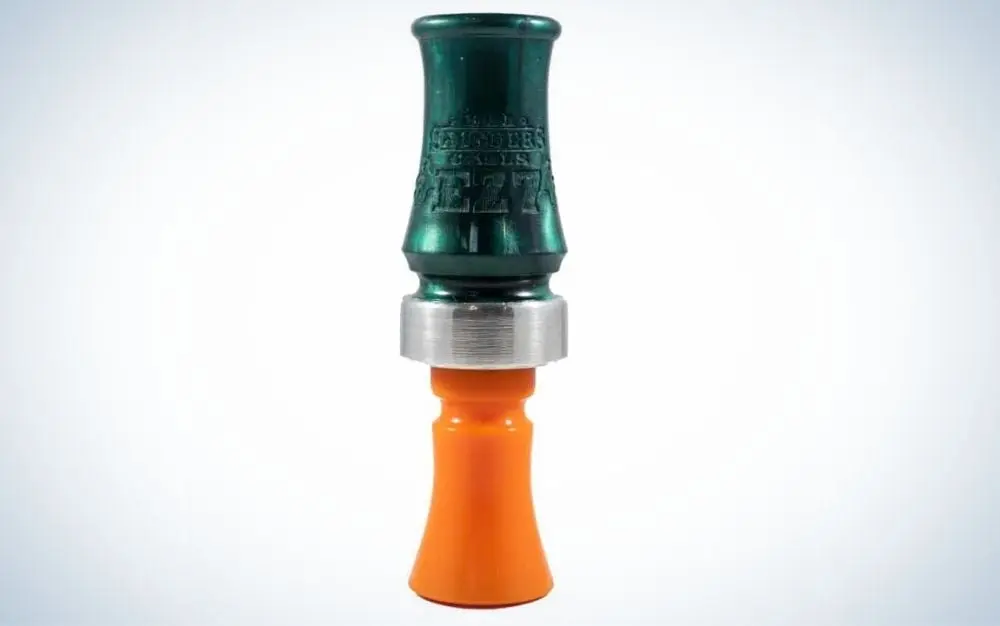
Bill Saunders EZ7 Bill Saunders Calls
Specs
Acrylic composite
Single reed
Exceptional customer service
Good ($70) price point
Pros
Backed by one of the best in the business
Versatile single, but blows like a double
Hand-tuned
Rugged acrylic design
Excellent highs and lows
Cons
Little bit of a learning curve (but not much)
I like Saunders for several reasons. He’s originally from Wisconsin—I’m a Buckeye State native—which makes him a skilled and avid walleye fisherman. He hunts ducks, geese, and turkeys, is a dedicated family man, and makes one hell of a duck call. And goose call, for that matter. And, what’s more, I have the poor guy on speed dial, so I can pester him with questions pretty much any time I like.
That said, his EZ7
is another in a long list, seven to be exact, of excellent duck calls to come out of Saunders’ workshop. The name comes from the fact that, with this call, it’s EZ to kill Washington state’s limit of seven (7) mallards. It’s every bit as good, if not a little better, than his earlier Fox, Clutch, and Refuge Series tools. A single reed, the EZ7 has a diverse repertoire, yet can be played—and well—straight away if a caller spends the time with it. The acrylic composite is tough, and should there be an issue, Saunders is but a phone call away and is happy to make things right.
Most Versatile: Buck Gardner 6-in-1 whistle
Most Versatile

Buck Gardner 6-in-1 whistle Buck Gardner
Specs
Constructed of tough hard plastic
No moving parts
Pea-less design
Inexpensive
Multi-lingual
Pros
Ridiculously easy to use
Good volume
Not a heartbreaker if broken, lost, eaten by dog, or stolen by buddy
Wide variety of sounds
Can be used as a dog whistle in a pinch
Cons
None
The Buck Gardner 6-in-1 I have on my working lanyard is over 20 years old. In fact, it was originally marketed as a “Hawk Call,” a whistle used to reproduce the scream of a red-tailed hawk and, hopefully, convince a wild turkey to gobble. It does that, and more, which is amazing when you think this is but one of seven wild sounds the 6-in-1 does—and does well. Let me put it this way: It’s like conjuring up Beethoven’s Sixth Symphony from a slightly used Zip-Lock bag. Yeah, it’s that cool.
For the ’fowler, the 6-in-1 can duplicate the sounds of a drake mallard’s lispy dweek; the trill of a drake pintail; the drake widgeon’s breathy woo-WHIT-woo; the high-pitched peep…peep of the green-wing teal; and the eerie squeal of both the drake and hen wood duck. Too, this little pea-less whistle does a damn fine job with the bobwhite quail, as well as the aforementioned red-tailed hawk. All for $7, and you’re not going to slip into a deep dark depression if/when it gets broke. I always, always, always have one on my Coyote Leather; you should, too.
Best Single Reed: Field Proven Single Shot
Best Single Reed
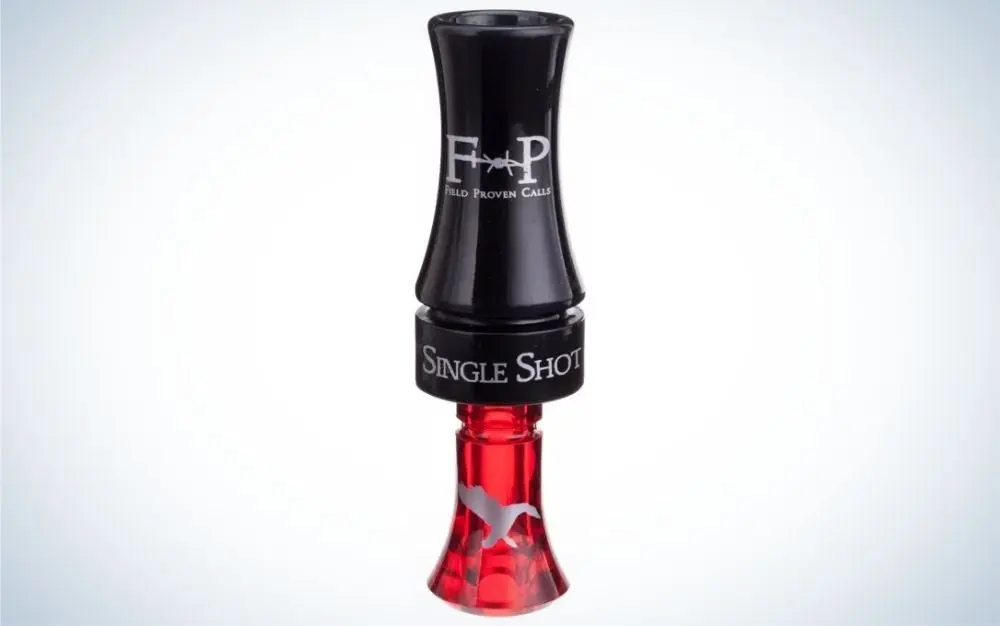
Field Proven Single Shot cabelas
Specs
User-friendly single reed
Over-bored mouthpiece for control ease
Durable yet handsome
Three different price points; same great call
Pros
Available as a polycarbonate, hybrid, and acrylic version
Top-notch service after the sale
Hybrid (wood/poly) option
Hand-tuned
Cons
Acrylic version is a bit pricey
Since 2000, Field Hudnall—one-half of Field Proven Calls, the other half being his brother, Clay—has competed in 107 calling competitions, both ducks and geese, and has placed in the top five (5) in 97 of those. Ninety-seven! So I’m going to say the young Kentuckian knows a little bit about calling things, along with making calls.
Hudnall’s flagship Single Shot single reed is about as user-friendly as a single reed gets, yet allows a new caller to grow into the call, per se, as his/her experience level and skills increase. In my opinion, it’s a really good-looking call—rugged and tough—but, and you’ll hear this again, pretty don’t kill ducks. That’s where Hudnall’s experience with a lathe, trimming tools, and his ear for what sounds right comes into play. And he stands behind his work 100 percent. You have a problem; he’ll fix it.
The Single Shot is offered in polycarbonate, full acrylic, and a poly/hedge wood hybrid, and at three different price points from $40 to $130, putting it in damn near everyone’s pocketbook.
Best Double Reed: Slayer Calls’ Drake Slayer
Best Double Reed

Slayer Calls’ Drake Slayer Slayer Duck Calls
Specs
Rugged and eye-catching acrylic construction
Engraved (SLAYER) silver band
Double mylar reeds
Tough rubber wedge
Made in the US of A
Pros
Ballpark priced ($135) for a full acrylic call
User-friendly double reed
Good volume control
Environmentally versatile, i.e. open water, timber, marsh
Cons
May be considered pricey for some budgets
Headquartered in Eagle, Idaho, Slayer Calls is one of the proverbial new kids on the ’fowling block, having just opened their doors—electronically, that is—in 2021. There wasn’t a hell of a lot of fanfare at first, until people got their hands on Bill Ayer’s, CEO and Slayer founder, duck calls. Then things changed, and calls like the company’s flagship Drake Slayer (DS) not only began to get noticed, but built up a good head ‘o steam. Today, Ayer’s outfit makes not only ’fowl calls, but elk and turkey calls as well, and is on the fast track to becoming a major player.
The Drake Slayer comes across as a high-end custom call at a most reasonable acrylic price. Every Slayer duck call is finished and hand-tuned by Mr. Ayers himself. Nothing goes out the door that he hasn’t had a hand, literally, in and on. I find the DS quite user-friendly, not prone to saliva-induced lock-up. It’s light—a full ounce lighter than either the Field Proven or ZINK calls I carry—but not so light as to not be ‘bouncy’ or feel unsubstantial. And I like that the DS is what I call ‘environmentally versatile,’ serving as well over in-close shallow sheetwater as it does in a wide-open tidal marsh.
Best Wood: Primos Classic Wood Duck
Best Wood Duck Call
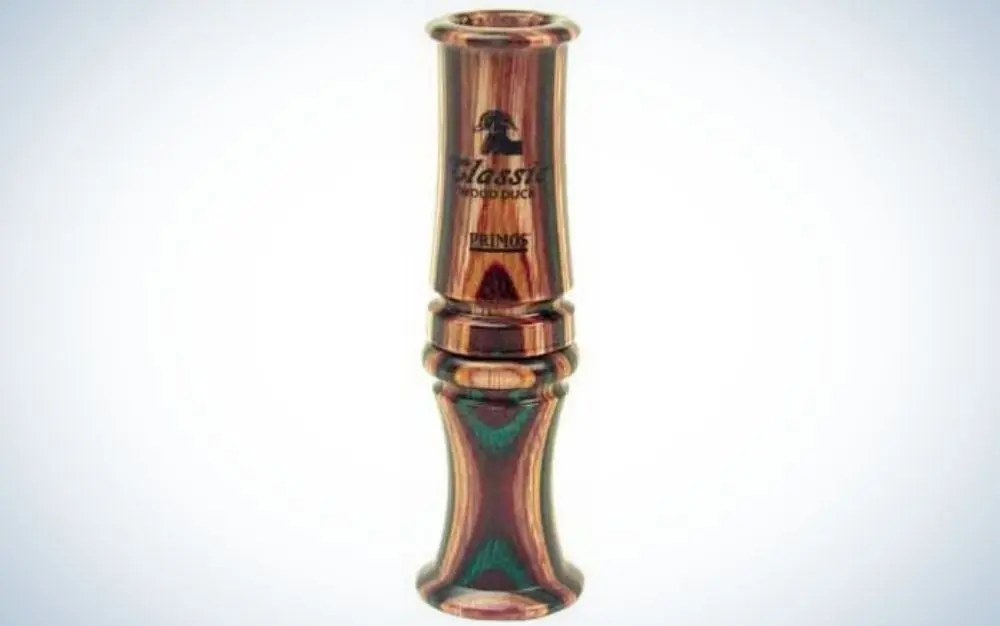
Primos Classic Wood Duck Primos Hunting
Specs
Beautiful Diamond Wood (Willow) build
Simple user-friendly short reed design
Available in ‘smoke’ polycarbonate
Pros
Mimics wood ducks on the water, as well as flying
Can double as a ‘peacock’ turkey locator call
High pitch carries well in buckbrush and flooded timber
Smoke poly, $10; Diamond Wood, $25
Cons
Limited applicability
Debate as to whether or not wood ducks respond to calls
As mentioned under the cons section, the debate continues as to whether or not Aix sponsa pays any attention to calls at all. I’ve personally seen them work, and I’ve seen them ignored. Some ’fowlers swear by ‘em, though, and blowing a wood duck call at a wood duck makes more sense (to me) than blowing a mallard call at a wood duck.
Primos’ Classic Wood Duck Call is a pretty little thing in Diamond Wood; rather Plain Jane in its smoke polycarbonate form. Both sport what I’ll call a short reed-esque insert, with a narrow tone channel and smallish dog-eared mylar reed, all of which work in synch to produce the high-pitched whines, squeals, and peeps of wood ducks either at rest on the water, or flying overhead. Do you need a wood duck call? If you’re in the Atlantic or Mississippi flyways, where Aix sponsa is most numerous, I reckon it couldn’t hurt.
Best Budget: Big Lake Calls Duck Popper Hunter’s Pack
Best on a budget
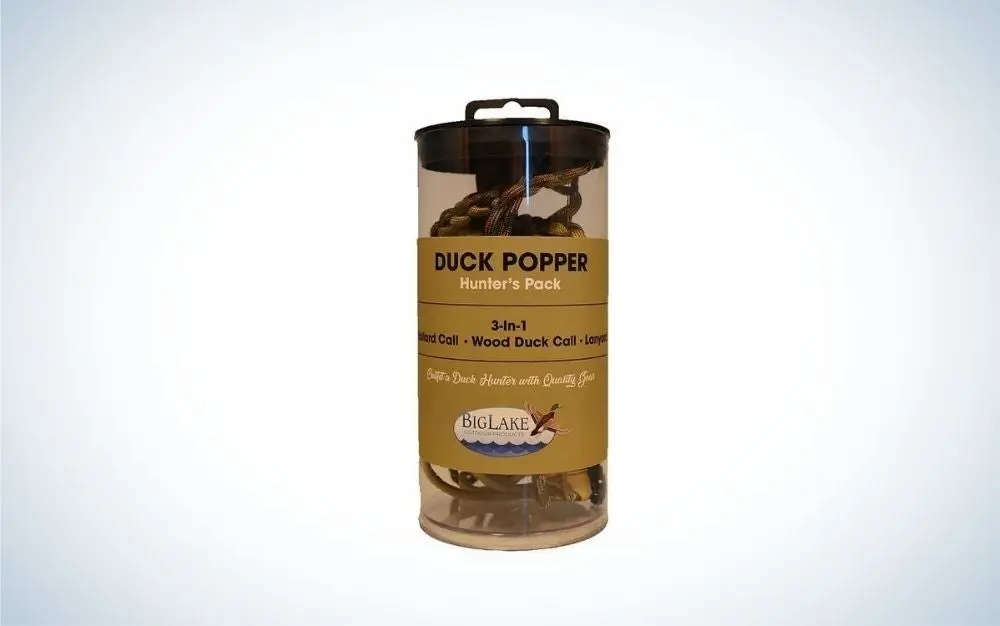
Big Lake Calls Duck Popper Hunter’s Pack Big Lake Outdoor Products
Specs
Pack includes mallard call, wood duck call, and traditional lanyard
Polycarbonate double reed mallard, with mylar and metal reeds
Camo polycarbonate “Perfect Woodie” wood duck call
Round lanyard, with four (4) sets of double loops
Pros
Great starter kit for the new ’fowler
Excellent ($55) price point
Makes a fantastic gift
“Perfect Timber” double reed is user-friendly/versatile
Cons
Western U.S. ’fowlers might find a pintail or widgeon call more useful
This one’s truly a no-brainer. Take two excellent calls—one a capable double reed mallard call, and the other a pretty little wood duck—set ‘em on a traditional round lanyard with more than enough droppers, package ‘em together, and put a price tag of $55 on it. You want champagne taste on a beer budget? Well, there you go, my friend.
Big Lake’s Duck Popper Hunter’s Pack starts with a right nice polycarbonate “Perfect Timber” double reed, complete with both mylar and metal reeds, and throws in the “Perfect Woodie”—Hello, Sigmund Freud—wood duck call. No, they’re not cutting edge. No, they’re nothing tremendously fancy. They are good-sounding meat calls on a lanyard that, with practice, can fool any mallard—and maybe a wood duck or two—that flies North to South in the fall. And for just $55.
Plus, I’ve been told there’s a high probability Big Lake will be offering the Duck Popper Hunter’s Pack with their Widgeon Magnet call in lieu of the Perfect Woodie for ’fowlers in the Central and Pacific flyways this fall.
Most User-Friendly: Buck Gardner Double Nasty
Most user-friendly

Buck Gardner Double Nasty Buck Gardner
Specs
Double reed design
Spit –Tech Technology
Full range; good highs and lows
Hand-tuned
Pros
Spit-Tech Technology blows when wet
Versatile double reed
Exceptionally user-friendly
Great service after the sale
Cons
None
I had the honor of meeting Buck Gardner
just four years after he won the World Duck Calling Championships in Stuttgart, Arkansas, in ’94, and to say I was impressed would be an understatement. Gardner walks the walk and truly talks the talk; the southern gentleman just knows ducks, and what’s more, he knows how to build a great-sounding duck call and make it available to the Common Man.
Heralded as the “cornerstone” of the company’s duck call line, the Double Nasty is as easy-blowing as they come. Sporting Gardner’s innovative Spit-Tech Technology, the DN can be blown wet; rather, it doesn’t lock up—guaranteed—when the tone board gets soaked, be it from saliva, condensation, or swamp water after an accidental dunking. She’s affordable, too, coming in at $30.
What to Consider When Choosing Duck Calls
Bear with me here when I say: Picking a duck call isn’t all that different from choosing a new vehicle. You do your research, uncover what’s available in terms of base models and options, overlay that availability onto your particular driving style and requirements, consider the price tag, and, once all that’s said and done, you make the purchase. Same story here, with that list of variables and considerations including the following.
Sound
I’d go so far as to say a call that reproduces the quack of a hen mallard in all its variations is universal. That is, if you can quack, you’re going to be reasonably well-set to “talk duck” throughout any of the four flyways, those being the Atlantic, Mississippi, Central, and Pacific. There are species-specific calls available—teal, wood ducks, pintails, widgeon, gadwall, and divers—but you’ll work your way into those soon enough.
Reeds
Today, the most common reed material is mylar, a type of tough plastic, with either one (single) or two (double) reed(s). However, metal reeds do exist, as do duck calls with three (triple) reeds. For most callers, a mylar reed(s) is the go-to. As for how many, a single reed is extremely versatile, but has a steeper learning curve than does the perhaps more user-friendly double reed. Either can work well.
Construction Materials
There are three primary choices in terms of the material used to create the duck call body—wood, polycarbonate (poly), a strong plastic material, and acrylic, aka Plexiglas, another durable plastic. Wooden calls look and sound great, but require care and maintenance because…well, they’re wood. Poly calls are less expensive than acrylic calls, but the latter is more attractive, if that matters. A good middle-of-the-road? Polycarbonate.
Custom v.s. Production Calls
Thousands of ducks are fooled each year by ’fowlers blowing production (mass-produced) calls. These instruments are less expensive than custom calls. However, with these mass-produced tools, one-on-one customer service, e.g. call tuning or questions, can be a challenge. Custom calls are, by nature, more expensive than production calls, but a buyer usually has access to the individual making the call, and can ask questions or discuss after-the-purchase services like tuning or parts (reeds and wedges/corks) replacement.
Price
Duck call price varies considerably, with a call out there that will fit everyone’s budget. Single or double-reed production calls might cost less than $15. However, higher-end custom acrylic calls in specialty colors, patterns, with/without engraving, extra reeds, hard cases, and backed by one-on-one customer service may push or exceed $200. It’s wise to shop around.
FAQs
Q: What’s easier—single reed, or double reed?
Single reed duck calls are extremely versatile in the sounds they can make; however, they can prove a bit more challenging for the novice to master due to the control (air delivery/pressure) needed to properly manipulate that single reed. Conversely, double reed calls are more forgiving and perhaps “easier” for the beginner to produce the proper sounds, but conventional wisdom says that double reeds—triple reeds, too—will output a smaller range of true duck sounds.
Q: Are wooden duck calls any good?
Wooden duck calls are undeniably beautiful, and the richness of wood produces, many believe, the most realistic of duck sounds. Unlike a synthetic material, e.g. polycarbonate or acrylic, wooden duck calls do require an uptick in care and maintenance, as factors such as prolonged moisture, extreme heat, or freezing temperatures can adversely affect their physical being. Too, wooden calls will expand and contract over time, thus changing tone (sound) to some degree.
Q: Are acrylic duck calls better than polycarbonate or wood?
Better? That really depends. If all three sound exactly alike, then the decision rests on three factors: Price, as acrylic is going to be more expensive than either polycarbonate or wood; Visual appearance, as acrylic is, to some, much more attractive than the others; and Usage, or how careful you want to be with your call. Acrylic is tough and stands up to abuse, much like polycarbonate; however, wood is going to be a bit more “fragile,” per se, than the other two. The bottom line is that wood versus polycarbonate versus acrylic is, for the most part, a matter of personal preference.
Best Duck Calls: Final Thoughts
Best Overall: Bill Saunders EZ7
Most Versatile: Buck Gardner 6-in-1 whistle
Best Single Reed: Field Proven Single Shot
Best Double Reed: Slayer Calls Drake Slayer
Best Wood Duck Call: Primos Classic Wood Duck
Best on a Budget: Big Lake Calls Duck Popper Hunter’s Pack
Most User-Friendly: Buck Gardner Double Nasty
Confused now? Well, you shouldn’t be. Choosing a duck call isn’t really all that tough once you’ve decided on how much you’d like to spend. Determine a price range—say—$40 to $90—and figure out how you’re going to treat that call, i.e. kid gloves (wood) or Devil may care (polycarbonate or acrylic), and go from there.
What do I know, without question, about buying duck calls? No one, myself very much included, stops at one. Never. There’s always room for another duck call.
Why Trust Us
For more than 125 years, Field & Stream has been providing readers with honest and authentic coverage of outdoor gear. Our writers and editors eat, sleep, and breathe the outdoors, and that passion comes through in our product reviews. You can count on F&S to keep you up to date on the best new gear. And when we write about a product—whether it’s a bass lure or a backpack—we cover the good and the bad, so you know exactly what to expect before you decide to make a purchase.
![Field & Stream [dev]](https://images.ctfassets.net/fbkgl98xrr9f/1GnddAVcyeew2hQvUmrFpw/e4ca91baa53a1ecd66f76b1ef472932b/mob-logo.svg)





